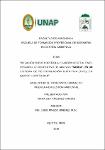Relación suelo hortícola y carbón vegetal en el desarrollo vegetativo de Aloe vera “sabila”, en un sistema de recirculación nutritiva (pvc), en Iquitos. loreto-2018
Abstract
La presente investigación trata de la relación suelo hortícola y carbón vegetal en el desarrollo vegetativo de aloe vera un sistema de recirculación nutritiva en condiciones de clima tropical de la región Loreto.
El principal factor de estudio es: proporción de suelo hortícola: carbón vegetal (tipo de sustrato). Los tratamientos en estudio los constituyeron cinco grupos de control, como factor principal de estudio. En una técnica de recirculación nutritiva (PVC). Se empleó el Diseño Completamente al Azar (DCA), con 10 replicaciones. El diseño tiene una sola fuente de variación y es debido a cinco grupos de contrastes (A, B, C, D y E). Considerándose una investigación mono factorial (Tipos de sustratos), se estudió el efecto del factor sustrato en función a la proporción Suelo: carbón sobre el desarrollo vegetativo de Aloe vera.
Los resultados obtenidos nos muestran que hay efecto de los sustratos orgánicos en el cultivo de la sábila en la mayoría de las características evaluadas, pues muestran diferencias estadísticas significativas sobre los caracteres altura de planta, ancho de planta, largo de hoja basal y peso de hoja basal, mientras que para ancho de hoja basal y diámetro no hay efectos de los sustratos. Los sustratos orgánicos en la proporción suelo y carbón mejora el rendimiento de la sábila con mayor altura de planta, ancho de planta, largo de hoja basal y peso de hoja basal, cultivados en la técnica de un sistema de recirculación nutritiva (PVC). The present investigation deals with the relationship between horticultural soil and charcoal in the vegetative development of aloe vera, a nutrient recirculation system under tropical climate conditions in the Loreto region. The main study factor is: proportion of horticultural soil: charcoal (type of substrate). The treatments under study were made up of five control groups, as the main study factor. In a nutritive recirculation technique (PVC). The Completely Random Design (DCA) was used, with 10 replications. The design has a single source of variation and it is due to five groups of contrasts (A, B, C, D and E). Considering a mono factorial investigation (Types of substrates), the effect of the substrate factor in function of the Soil: carbon ratio on the vegetative development of Aloe vera was studied. The results obtained show us that there is an effect of organic substrates in the cultivation of aloe in most of the characteristics evaluated, since they show significant statistical differences on the characters plant height, plant width, basal leaf length and leaf weight. basal, while for basal leaf width and diameter there are no effects of the substrates. The organic substrates in the soil and carbon ratio improves the yield of aloe with greater plant height, plant width, basal leaf length and basal leaf weight, grown in the technique of a nutrient recirculation system (PVC).
Collections
- Tesis [508]
The following license files are associated with this item:


